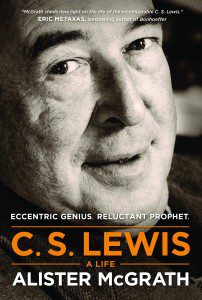 Contrary to public opinion both among critics and many Christians, Christian faith is intended to be imaginative rather than restrictive. Some people obviously believe some version of the following, “The Bible says it, I believe it, and that settles it.” But, such understanding of scripture and the Christian life makes the words of scriptures dead letters; the end of discussion rather than the beginning of a holy adventure. Faith is a way of experiencing reality. As Alistair McGrath says, in describing C.S. Lewis, faithful imagination is “a certain way of seeing that brings it [reality] into the sharpest focus, illuminating the shadows and allowing its inner reality to be seen.” Lewis described this as “realising imagination,” I call it “holy imagination.” Paraphrasing the Epistle of James, “faith without imagination is dead.”
Contrary to public opinion both among critics and many Christians, Christian faith is intended to be imaginative rather than restrictive. Some people obviously believe some version of the following, “The Bible says it, I believe it, and that settles it.” But, such understanding of scripture and the Christian life makes the words of scriptures dead letters; the end of discussion rather than the beginning of a holy adventure. Faith is a way of experiencing reality. As Alistair McGrath says, in describing C.S. Lewis, faithful imagination is “a certain way of seeing that brings it [reality] into the sharpest focus, illuminating the shadows and allowing its inner reality to be seen.” Lewis described this as “realising imagination,” I call it “holy imagination.” Paraphrasing the Epistle of James, “faith without imagination is dead.”
When I was a teenager growing up in the San Francisco Bay Area, I devoured Tolkien’s Hobbit and Lord of the Rings series. Liberated by herbal or psychedelic concoctions, I imagined myself as Bilbo Baggins or Gandalf venturing in a world filled with threats as well as treasures. In fact, it was then and still is now a world of adventure, threat, and treasure as we hurtle spinning in space, with asteroids flashing by. Some thirty years later, my text Holy Adventure was a homage and creative transformation of those imaginative years in the sixties, when anything seemed possibilities and every pathway held promise of a heroic journey. Later, I recall reading Joseph Campbell and discovered that the point of scripture is not to teach us doctrine but to invite us on an unending adventure. Just as I could imagine myself as Bilbo, Frodo, or Gandalf, I could now see my story as paralleling the adventures of Abraham and Sarah, Jacob, Isaiah in the Temple, Mary of Nazareth, Peter, Paul, and Esther. My sojourns in the wilderness were not just my own, they shared in Jesus’ holy adventure of temptation and vocation. The life of faith is a heroic challenge to imagine the impossible and then embody it in companionship with an imaginative God.
Doctrines may, in the hands of some, be boring, backward-looking, and confining; in the hands of others, they may be inviting, illuminating, and adventurous, inviting us to see ourselves and the world, as Paul says, no longer from a human point of view but as God sees it, or – William Blake asserts, seeing everything as infinite.
These are adventurous times calling for the most imaginative of faiths. This is the heart of Alistair McGrath’s C.S. Lewis – A Life (Tyndale House). While McGrath, Lewis, and I may articulate the holy imagination of adventurous Christianity in different ways, we all know that every room may contain a “wardrobe” with a pathway to Narnia, Galilee, the Shire, or Middle Earth. On such a path way, we may discover powers, energies, and threats unavailable to those who lack theological imagination, whose faith pushes them into deeper waters of wonder and stretches doctrine to the limit in a 125 billion galaxy universe. Perhaps, we will encounter Dorothy, the Wizard of Oz, Yoda, or ET on the adventure, and along the path we may also encounter Jesus whose presence in Galilee lights up the skies of our own intergalactic imaginations. We may discover a wild lion whose mission is to invite children as well as adults to push the boundaries of imagination and take our places in the quest to heal the planet.
Alistair McGrath’s C.S. Lewis is an invitation to “think big.” For those who follow Jesus, we are counseled to “make no small plans,” even if our adventures never take us far from home. The adventures of an omnipresent God, as wild as untamed (like Aslan) as our imaginations, invite us to ponder each moment as a “holy moment” and each space as a “thin place,” transparent to transcendence and intimate to immanence. Our traveling prayer might be “God in all things and all things in God,” or “Christ above, Christ below, Christ behind, and Christ ahead,” or “with beauty – or adventure – all around I walk.”
As teenager, I read the Lord of the Rings and Carlos Castaneda’s Teachings of Don Juan. As a parent, I read The Chronicles of Narnia with my young son and later we filled our imaginations with “Star Wars.” As a grandparent, I am reading Winnie the Pooh with my grandson and am rediscovering that we are always in “the hundred acre wood” and always on the verge of a “wee adventure.” As a Christian, I can’t expect life to be any different: after all, we tell stories of bread and wine as holy food, touch that energizes and cures, words that change lives, and heavens that declare God’s glory. With Annie Dillard, we should enter church with awe and fascination and a little fear and trembling, “Ushers should issue life preservers and signal flares; they should lash us to our pews.” After all, Aslan is not a tame lion. But, in imaginative faith, we encounter a goodness and beauty belief that makes every moment sacred, every encounter transformative, and every step part of a holy adventure.
Although some think of C.S. Lewis as a champion of orthodoxy, Lewis’ vision is far from orthodoxy, if orthodoxy, means looking backward and assuming adventure is a thing of the past. Aslan calls us forward into wild territory and receding horizons. Our faith must be large enough to find God in the big bang, the Hubble telescope, the slow process of evolution, and the adventures of our everyday lives. Onward we go into Narnia, the Hundred Acre Wood, a galaxy faraway, or the Middle Kingdom; onward we go off to work, school, coffee, or playing with our children or grandchildren! What ho! The adventure is here, God is venturing with us.
For more conversation on C.S. Lewis, A Life, visit the Patheos Book Club here.












